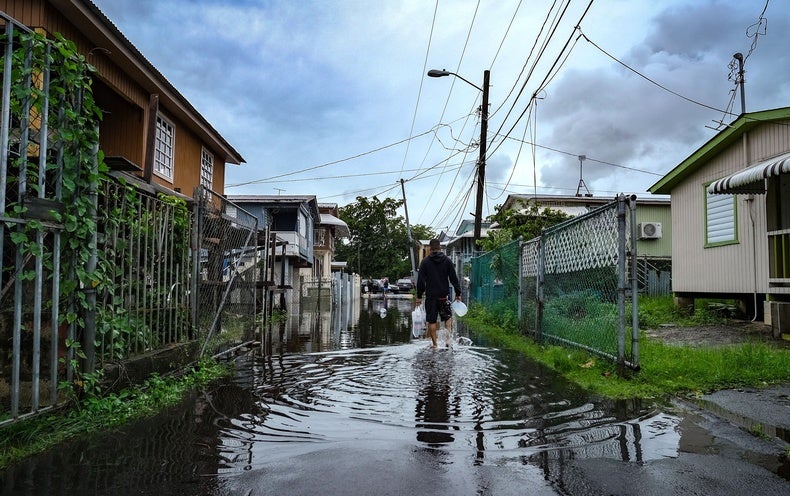It was a moderate hurricane whose damage seemed tame compared to the destruction five years earlier from Hurricane Maria.
But in the weeks since Hurricane Fiona hit Puerto Rico, the Federal Emergency Management Agency has given emergency aid to far more residents of the U.S. territory than after Maria demolished the islands, records show.
The startling contrast is the most visible example of how policy shifts by the Biden administration since 2021 have made it easier for people in disaster areas to qualify for emergency cash, housing aid and supplies. The changes aimed to address concerns that FEMA was distributing disaster aid inequitably.
“This is a direct result of policy changes and program enhancements,” FEMA spokesperson Jeremy Edwards said. “FEMA has put equity and accessibility at the center of our mission.”
Since Fiona hit Puerto Rico on Sept. 18, FEMA has approved disaster aid for over 645,000 individuals and households, agency records show. The figure will increase as Puerto Rico residents continue to apply for aid, FEMA said.
After Hurricane Maria in 2017, FEMA approved aid for 475,000 individuals and households.
Fiona was a Category 1 storm. Maria was a Category 5 monster that killed an estimated 3,000 people, destroyed $100 billion in property and left most of Puerto Rico without power for months.
The number of people receiving FEMA disaster aid after Fiona is more than triple the number who received the aid after Superstorm Sandy swept across the Northeast in 2012, FEMA records show. Roughly 25 million people in five states, including all of New Jersey, New York City and Long Island, were eligible for FEMA disaster aid after Sandy.
All of Puerto Rico’s 3.3 million people are eligible for FEMA aid.
The expanse of the post-Fiona aid reflects both a large volume of applicants and a high approval rate due to changes FEMA made in 2021 to its aid programs and temporary waivers approved in recent weeks for Puerto Rico.
Just over 1.1 million people have applied for FEMA aid in response to Fiona — the same number that applied for aid after Maria.
But FEMA has approved 57 percent of the Fiona applications, compared with 42 percent of the Maria applications, according to an E&E News analysis of FEMA records.
FEMA’s approval rate for emergency aid over the past 20 years is 44.5 percent, the analysis shows.
“The two emergencies are diametrically different. On this occasion, we have noticed that FEMA has been better prepared in the process before, during and after the hurricane,” said Eddie Alicea Sáez, executive president of Cooperativa La Sagrada Familia, a credit union in Puerto Rico that established a community resilience center after Maria.
“Many of the failures that occurred during Hurricane Maria were probably corrected. In the end they learned, like we have, from the experience,” Sáez added.
FEMA aid to individuals is typically worth only a few thousand dollars and pays for expenses such as short-term hotel stays, minor home repairs and emergency supplies. The aid is not intended to help people make permanent home repairs or replace all their belongings.
But FEMA’s emergency aid — known as Individual Assistance — has drawn scrutiny from lawmakers and advocates over reports that people who have low incomes or are members of minority groups have been disproportionately denied help following hurricanes, floods and other events.
Most Individual Assistance goes to homeowners for temporary home repairs and short-term rental assistance. But FEMA has rejected aid for countless people who could not prove they owned a home that was damaged in a disaster because they lacked property deeds, mortgage documents or other official records.
The rejections were acute in Puerto Rico, where legal records are incomplete, and in southern states among Black homeowners, who were historically shut out of legal systems and transferred real estate informally to relatives, without legal documentation.
FEMA Administrator Deanne Criswell took a major step in September 2021 to address the inequity by expanding the list of documentation that applicants could use as proof of homeownership to include records such as home-repair bills and court documents. The expanded list also applies to renters, who must prove that they live in a home located in a disaster-declared county (Climatewire, Sept. 9, 2021).
In the case of Fiona, FEMA approved a waiver requested by the Puerto Rico government that allows residents to receive $700 for “critical needs” without providing documentation that they have been displaced from their home. FEMA typically requires residents to show they are displaced to get the aid, but the agency waived the requirement after Fiona because so many people in Puerto Rico did not have electricity or access to drinking water or shelters.
Most Puerto Rico residents receiving aid have been approved only for “critical needs assistance,” which provides much less money than housing aid.
FEMA said 86 percent of the aid applicants reported that their homes sustained only minor damage and were safe to occupy.
As a result, the average FEMA payment so far is just $754 — the lowest average payment for any disaster since 2002, FEMA records show. That’s far below the 20-year average of $3,364 and the average payment after Maria, which was $2,812.
FEMA officials said the average payment in Puerto Rico after Fiona likely would increase as the agency inspects homes for damage and applicants appeal FEMA decisions.
Reporter Avery Ellfeldt contributed.
Reprinted from E&E News with permission from POLITICO, LLC. Copyright 2022. E&E News provides essential news for energy and environment professionals.
































